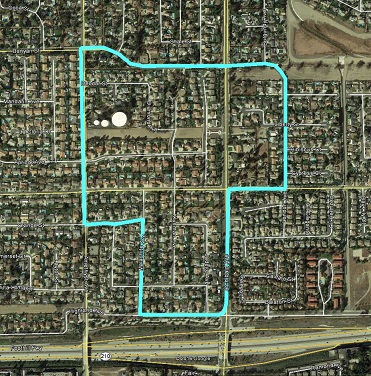Mobile Platform Measurements
Since May 19, 2017, the day after SCAQMD was notified of the incident, SCAQMD staff has been conducting mobile survey measurements in and around Alta Loma in Rancho Cucamonga to better characterize methane concentration levels and concentration gradients. For this purpose, a state-of-the-art methane analyzer (LI-COR 7700) and a Global Positioning System (GPS) were mounted on top of a hybrid vehicle and driven around the neighborhood where the repair work is being conducted and in other nearby surrounding areas of Alta Loma in Rancho Cucamonga as shown in the map below.

This equipment measures instantaneous methane levels, which helps to identify which areas may have higher than typical levels of methane that could be due to a leak or off-gassing. Methane is the main component of natural gas, and a good indicator for detecting natural gas leaks. SCAQMD staff also collected air samples for laboratory analysis, which will provide information about other compounds that are found in natural gas. The results from the laboratory samples will be posted when the analysis, quality assurance, and reporting are complete.
Summary of Results from Mobile Platform Measurements
In general, results from the mobile platform measurements in Alta Loma have indicated that levels of methane are typical of those seen across the region. However, elevated instantaneous levels of methane in the areas nearby the La Gloria Drive and Archibald Avenue, the primary area of repair work, and also Lemon and Archibald. The elevated levels observed were very localized and not wide spread.
The highest instantaneous methane concentrations measured thus far, up to 58 part per million (ppm), were recorded near the intersection of Archibald Avenue and Lemon Avenue Elevated methane levels, up to 44 ppm, were also measured around a residential property located near Archibald Avenue and La Gloria Drive. For comparison the background methane concentration found in most urban environments is about 2-3 ppm. SCAQMD is still conducting mobile measurements in this community.
Monitoring was conducted in the morning or afternoon and under different meteorological conditions (e.g., winds were generally calmer in the morning).
At the initial stages of SCAQMD's of investigation, measurements taken at ground level by TVA monitoring equipment were in the flammable range. Measurements by LICOR mobile monitoring equipment, which is mounted on top of a vehicle, are taken from several feet up in the air. The LICOR measurements were well below the flammable range.
Summary of Results from Short-Term Samples
SCAQMD staff collected several outdoor air samples that were analyzed to determine the levels of several air pollutants, including some air pollutants that are considered air toxics. The sampling locations included outdoor areas on the street, areas near the punctured gas line, areas near a gas meter on the ground, one location at the source of the gas leak, and other locations in both public access areas as well as a limited number of samples in outdoor areas on private residential properties. All samples collected were short-term (“grab”) samples, so the results were compared to short-term health-based thresholds for air toxics (acute reference exposure levels, or acute REL’s, which are established by the California Office of Environmental Health Hazard Assessment).
The following is an assessment of the results from samples collected between 5/19/2017 through 5/21/2017: The highest levels of gases in these samples were found in the sample collected at the source of the gas leak (near the intersection of Archibald Avenue and La Gloria). The levels of gases in the samples collected further from the leak source were lower, and more representative of what residents could be breathing in the outdoor air. The methane levels in all these canister samples, including the sample collected at the source of the gas leak, were well below flammable levels. The observed higher values of lighter hydrocarbons (e.g. ethane, propane, and butane) are found in natural gas but are not toxic air contaminants. While some air toxics were detected in these samples, the levels of air toxics detected were all well below acute REL’s, meaning that short-term exposures to air toxics at these levels are not expected to cause health effects.
Not all air toxics have acute REL’s, since some of them are not known to cause short-term health effects. Therefore, the data were also compared to information from the Multiple Air Toxics Exposure Study IV (MATES IV), which provides a regional estimate of the “background” levels of air toxics in 2012-2013 from 10 locations throughout the region. The purpose of these comparisons is to indicate whether the levels measured in these samples were roughly consistent with air toxics monitoring data across the region, while considering differences in sampling time (i.e. the Alta Loma samples were short-term samples, while MATES IV used 24-hour samples collected over the course of a year). If a short-term sample result is well within the range of the MATES IV 24-hour sample results, then a longer-term average at that level would be roughly within the range of typical levels.
Many of the air toxics measured in the Alta Loma community samples had levels that were too low to be detected. For those air toxics that were detected, the levels in the Alta Loma community samples were roughly similar to typical levels detected elsewhere in the region in the MATES IV study. Four air toxics (1,2-dichloroethane, acetone, benzene, and MEK (2-butanone)) had one or more samples that were slightly above the typical range found in MATES IV. However, for 3 of these pollutants (1,2-dichloroethane, acetone, and benzene), the only sample that exceeded the 95th percentile levels from MATES IV was the sample collected at the source of the gas leak; the other community samples were within the typical range of levels detected in MATES IV. For 2-butanone (methyl ethyl ketone), the source gas sample and a second sample near a gas meter on the ground were the only 2 samples that were above MATES IV levels, but all samples were below the acute REL’s, meaning that short-term health effects are not expected at these levels.